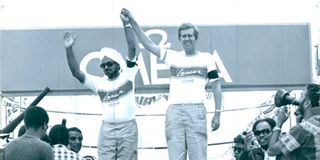Management changes raise rally’s profile

The 1976 Safari Rally Winner, Joginder Singh and David Doig the finishing ramp at Kenyatta Conference Centre.
What you need to know:
- There were three drivers of Asian extraction amongst the finishers and one of them, Joginder Singh, navigated by Raman Patel raised eyebrows in ninth.
- Little did the world of motorsport know that he would go on to become one of the three greatest Safari drivers of all time, a national icon whose story will forever be intertwined with that of the Safari Rally.
The Coronation Safari Rally had gradually grown from humble beginnings of a purely amateur sport for local farmers and garage owners to an international rally within seven years.
From 1959, the Safari, like all other spheres of life in Kenya, was being swept by the independence political wind of change blowing across Africa as the 60s’ decade approached.
Safari organisers made management changes in preparation for the rally morphing into an international contest they never thought would come this far.
They convinced Arthur Burton — the 1957 winning navigator for Gus Hofmann in a VW Beetle — to take up a full-time job as the first Executive Manager of the Safari.
Burton co-ordinated many activities, directly engaging foreign teams, including manufacturers, with the first-hand experience of one who had been at the forefront and had seen the evolution of the Safari Rally since 1953.
Burton did a superb job, accepting the first-ever factory team entries from Ford and Hillman which changed the Safari Rally’s brand at home and abroad.
Ford flew in Edward Harrison and Denis Scott t to join 1954/55 champion Vic Preston in Ford Zephyrs while Peter Hughes, who was to win in 1964, was joined by R. Coombes and Derek Shepherd in the Ford Anglia team.
Rootes Motors nominated Ron Dalton, Peter Harper, Peter Jopp and Paddy Hopkirk to drive the Hillman Husky models as Ronnie Adams was given a Humber Super Snipe.
This means that for the first time, locals were given cars made in the factory abroad to drive instead of their own locally prepared variants.
Local motor companies noted this, especially D.T. Dobie and Marshalls East Africa who prepared their cars using local knowledge and employed the services of senior field officials for the job at hand.
In a bid to avoid the protests of the previous year regarding broken seals of some competition parts which saw the final results protested in 1957 all the way to the headquarters of the Royal Automobile Club (RAC) in London, the organisers introduced radioactive paint to replace mechanical seals.
The Safari was 5,150km long, the longest so far in seven years, and right from the beginning locals played a wait-and-see game to see how the Europeans were fairing.
Soon the strong and better-prepared Mercedes Benz cars started to show superior form through Tanzania.
Mercedes lead driver Bill Fritschy and Jack Ellis proved unstoppable after favourite Vic Preston in the Zephyr ran out of fuel in Tanganyika and had to improvise with fuel tank bypass pipes from a jerry can held by his co-driver Ken Springer inside the car to keep the engine running.
They spent a substantial amount of time replacing the tank but the car was beyond repair.
The race was finally reduced to a straight fight between Fritschy and Scott but the latter incurred a huge penalty time in Nakuru which he could not cancel paving the way for the former to claim the 1959 Coronation Safari Rally.
There were three drivers of Asian extraction amongst the finishers and one of them, Joginder Singh, navigated by Raman Patel raised eyebrows in ninth.
Little did the world of motorsport know that he would go on to become one of the three greatest Safari drivers of all time, a national icon whose story will forever be intertwined with that of the Safari Rally.




